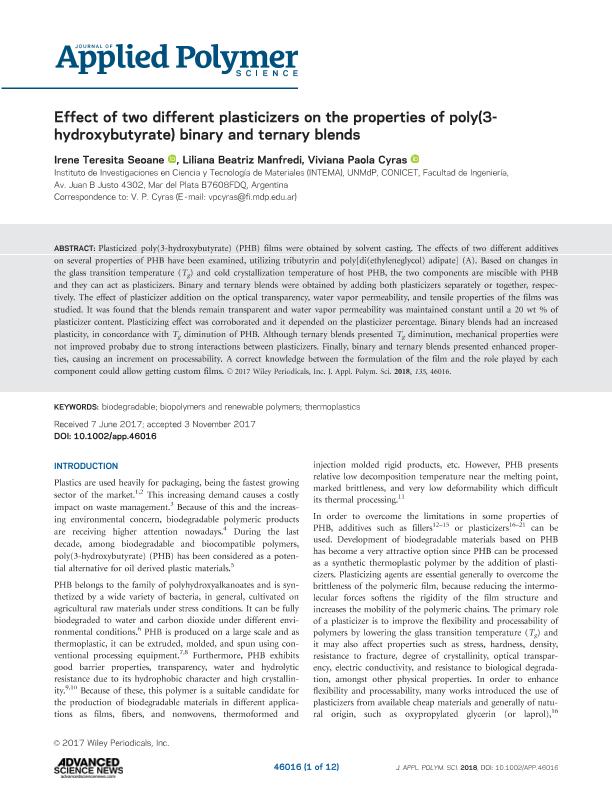Artículo
Effect of two different plasticizers on the properties of poly(3-hydroxybutyrate) binary and ternary blends
Fecha de publicación:
03/2018
Editorial:
John Wiley & Sons Inc
Revista:
Journal of Applied Polymer Science
ISSN:
0021-8995
Idioma:
Inglés
Tipo de recurso:
Artículo publicado
Clasificación temática:
Resumen
Plasticized poly(3-hydroxybutyrate) (PHB) films were obtained by solvent casting. The effects of two different additives on several properties of PHB have been examined, utilizing tributyrin and poly[di(ethyleneglycol) adipate] (A). Based on changes in the glass transition temperature (Tg) and cold crystallization temperature of host PHB, the two components are miscible with PHB and they can act as plasticizers. Binary and ternary blends were obtained by adding both plasticizers separately or together, respectively. The effect of plasticizer addition on the optical transparency, water vapor permeability, and tensile properties of the films was studied. It was found that the blends remain transparent and water vapor permeability was maintained constant until a 20 wt % of plasticizer content. Plasticizing effect was corroborated and it depended on the plasticizer percentage. Binary blends had an increased plasticity, in concordance with Tg diminution of PHB. Although ternary blends presented Tg diminution, mechanical properties were not improved probaby due to strong interactions between plasticizers. Finally, binary and ternary blends presented enhanced properties, causing an increment on processability. A correct knowledge between the formulation of the film and the role played by each component could allow getting custom films.
Palabras clave:
BIODEGRADABLE
,
BIOPOLYMERS AND RENEWABLE POLYMERS
,
THERMOPLASTICS
Archivos asociados
Licencia
Identificadores
Colecciones
Articulos(INTEMA)
Articulos de INST.DE INV.EN CIENCIA Y TECNOL.MATERIALES (I)
Articulos de INST.DE INV.EN CIENCIA Y TECNOL.MATERIALES (I)
Citación
Seoane, Irene Teresita; Manfredi, Liliana Beatriz; Cyras, Viviana Paola; Effect of two different plasticizers on the properties of poly(3-hydroxybutyrate) binary and ternary blends; John Wiley & Sons Inc; Journal of Applied Polymer Science; 135; 12; 3-2018; 1-12; 46016
Compartir
Altmétricas




